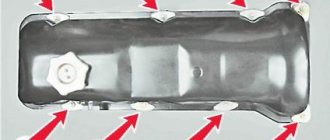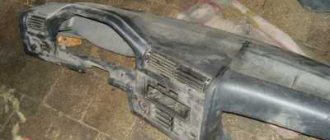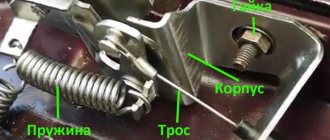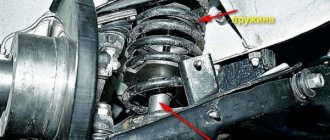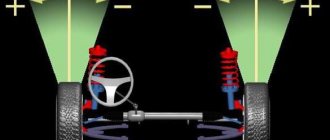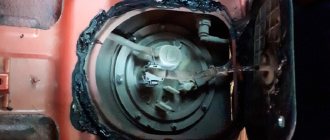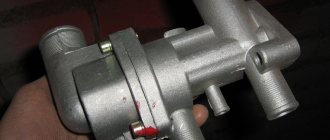VAZ cars, despite their age, are still popular among car enthusiasts. Based on the number of shortcomings of domestic cars, owners are forced to resort to improvement and modernization of certain elements of vehicles. This article will talk about tuning the VAZ-2107 stove, since it is the weak link of the vehicle.
It often happens that the standard VAZ 2107 stove cannot cope with severe frosts
Everyone knows how important the heating system of a car is for the comfort of the driver and passengers during cold winter periods. Freezing windows and cold in the car create great discomfort. Let's look at the main options for improving the vehicle's stove.
You can improve the operation of the heating system on the “seven” in the following ways:
- redo side window ventilation;
- modernize the damper;
- modify the foot airflow system to increase its efficiency;
- improve the operation of the rear cabin heating system;
- modify the thermostat;
- improve the functioning of the steam exhaust line;
- install an additional water pump.
User Egor Panther spoke about options for upgrading the heating system in VAZ 2107 cars.
Improved side ventilation
The side ventilation system needs to be modified after purchasing an additional fan. The device is mounted in the left line, which will allow forced air flow to the deflector.
The tuning procedure looks like this:
- At the first stage, the deflector device is dismantled from the main line. To perform this task you need to use a screwdriver. The deflector in the cabin is pryed up and removed; it must be pulled forward. Similar actions are performed on the other side of the stove.
- Dismantling the device is carried out carefully so as not to leave any traces of damage on the center console.
- If the deflector is removed, it is necessary to remove the holding device from the dashboard. This element is mounted in the center console using special antennae. The essence of this modernization is that a classic computer fan is installed to force air flow into the heating system.
- To install the ventilation device, the element must first be fitted to the deflector body. After applying it to the plastic with a marker or pencil, you need to apply markings. Using a utility knife, a cut is made in the plastic on the deflector.
- If the dimensions are marked accurately, the ventilation device will be tightly installed in the housing. This is important, since such installation will prevent the part from loosening while driving.
- After completing the installation of the fan, you need to make sure that its blades rotate normally and nothing interferes with them. If problems arise, the device is adjusted. If necessary, the blades can be trimmed a little.
- To ensure efficient air flow and no backdraft, the entire structure must be sealed. Therefore, using sealant or the remains of plastic that appeared after cutting the deflector, the cracks are clogged.
- If all steps are completed, the ventilation device is installed in the main line area, and then mounted on the body of the deflector element.
- After completing all the installation steps, you need to work with the electrical component. It is recommended to connect the fan electrical circuit to the conductor where the current appears when the ignition is activated. This option is more convenient. It is possible to connect the device to the heating unit control cable.
Damper modernization
Modification of the VAZ 2107 stove, which consists of upgrading the lower damper of the system, is the easiest option to implement. If all actions are performed correctly, the device will not open or close randomly when the car drives over bumps. This will ensure efficient and equal airflow on both glasses.
The upgrade procedure is carried out as follows:
- It is necessary to visually evaluate the housing of the heating unit. In its corner there is a hole of the required diameter to carry out the work. If it is not there, then it is drilled. For this, a drill with a diameter of 6 mm is used.
- A bolt is installed into the hole made from the inside. The valve itself closes.
- After this, using the same drill, a hole is drilled directly into the handle of the device. It is necessary to drill so that the hole is located at the level of the bolt installed earlier. In this case, the length of the screw must be such that when lifting the damper, the element can freely fit into the hole made.
- If everything is done correctly, the bolt is tightened with a nut. It is recommended to use a black part, then it will be difficult to see.
User Nail Poroshin spoke about the features of modifying the air damper thrust.
Rear seat heating system upgrade
To modernize the rear seat heating system, you will need to install an additional “snail”, which can be used from the VAZ 2108:
- First you need to make a housing to fix the “snail”. To perform this task, you need to cut plexiglass.
- Using a regular hairdryer, you need to carefully make bends on the glass so that it turns out as shown in the photo.
- Then, using a hair dryer, you need to carefully change the shape of the case. It is necessary to act carefully, otherwise the “snail” may not fit into the landing site.
- When completing the task, you can remove the device plug using a utility knife. This will reduce the dimensions of the part by approximately 3 cm.
- Then the side walls of the structure are manufactured. For this you can use duralumin or other similar material. The wall thickness should be 1.5 mm.
- The next step is to remove all the cracks. To do this, the joints of the device must be sealed using adhesive-sealant or other means.
- Then you need to work with the channels through which air will flow to the blower openings. It is recommended to make these elements collapsible. For manufacturing it is desirable to use a similar material.
- In order to reduce the amount of resistance and remove turbulence, the turns of the air channels must be smooth. They can be made from duralumin.
- At the next stage, we need to build slots that will be used to warm the feet. We are talking about front airflow - for the driver and passenger. The slots must be equipped with shutters. You can additionally install a variable resistor device, which will be used to regulate the speed of the electric motor. This element can be used instead of a resistor designed to change the brightness of the backlight.
- The main stage in this modernization is the construction of a system for effectively heating the feet of passengers sitting in the rear. To do this, it is necessary to additionally install several longer pipes. The radiator device is quite powerful and its power will be enough to supply air flow back. All connecting points of lines and blowers are sealed to prevent leakage of warm air flow.
Using a hair dryer, a body for the “snail” is made from plexiglass
Removing the snail plug
Modernization of the housing for the production of air channels
We recommend: How to repair a xenon ignition unit with your own hands
Improved foot airflow efficiency
To improve the efficiency of blowing the legs, you will need to replace the standard fan with another; you can use a device from a VAZ 2108.
The upgrade procedure is performed as follows:
- The first stage is performed inside the car. It is necessary to dismantle the lower part of the heating unit. A standard ventilation device is installed here.
- The fan is being dismantled. It will no longer be needed and can be recycled.
- Next, the plastic ridge is cut, which supplies the air flow to the floor of the machine. On “eight” units, the fan motor is larger in size.
- A ventilation device equipped with two blades is dismantled. A knot with five elements will be used instead. Before installing a new device, it is necessary to diagnose the quality of its operation. To do this, the node is connected and checked.
- If the device works correctly, then it is installed instead of the old one. After installation, the unit must be properly fixed. This will prevent the negative impact of vibrations during movements and rapid failure of the device.
- In order for the ventilation unit to function more smoothly, it is necessary to replace the resistor element. This is due to the fact that the device allows for a larger volume of air flow and operates noisier. Therefore, a resistor element is installed, which can be used from a VAZ 2108.
- The buttons, as well as the control components of the ventilation device, must be replaced with new ones. It is allowed to use parts from the VAZ 2108. The standard key from the “seven” is suitable in size and mounting. But it quickly fails as a result of a large difference in current. At this stage, the modernization procedure can be considered complete.
Modification of the thermostat
Thermostat from a Chevrolet Niva car
The procedure for modifying the thermostat on a VAZ 2107 involves replacing the standard device with a part from a Chevrolet Niva:
- First, the refrigerant from the cooling system is drained. The car engine warms up, a container is placed under the heater tap and the liquid is drained.
- The engine compartment is opened, the thermostat with the lines connected to it is dismantled. It is necessary to disconnect the outlet pipe located at the bottom; it goes from the radiator device to the element being replaced. The bypass line is disconnected; it is installed on top, as well as the hose going from the thermostat to the pump. The condition of these pipes is assessed. If they are worn out or damaged, then new ones must be prepared.
- The refrigerant outlet pipe and the copper pipe are disconnected. The last element is unscrewed from the pump; to do this, you need to unscrew two nuts and remove the flange from the studs.
- The lower removed line is taken and the middle part is cut out of it. The length of the segment should be about 7-9 cm.
- A new thermostat device is being installed. Its connection is made using a pipe with a water pump. The hose must be slightly bent in advance.
- Then a thick pipe from a VAZ 2108 is taken and adjusted to the place where the lower standard hose was installed. You need to cut off identical parts from both ends of the element and connect it to a new device. In principle, it is also possible to install a standard line, but this option is simpler.
- The upper hose is being installed; we are talking about a standard pipe.
- Instead of the dismantled line, a plug is made; it went from the heating unit to the water pump. To do this, you will need a copper tube; a connecting flange is soldered off from it. A sealing element is made from rubber, then the surface of the pipe is treated with sealant. The structure is screwed back to the water pump.
- The next step is to connect the pipe that removes the refrigerant from the heating device with the inlet on the thermostat. To complete the task, take a dismantled copper hose, remove the excess part, then bend it a little.
- A bracket is made that will be used to fix the pipe to the exhaust manifold device.
- The outlet line from the heating unit with the hose, which was previously disconnected, is connected. The output from the stove remains the same, but the input will go not to the pump, but to the thermostat.
- The end of the line with the corresponding input is connected to the thermostat device; this will require a shorter and curved pipe. It is used to remove refrigerant from the cylinder head to the heating unit. This element must be adjusted to length in advance. Difficulties may arise when using an aluminum thermostat because the walls of such devices are thicker. This means that the line must be used with a large diameter.
- The thin pipe of the heating system of the intake manifold is fixed to the thinnest outlet of the thermostat. First you need to disconnect the end going to the lower line from the heating device to the water pump. The pipe is measured and, if necessary, the excess part is sawed off. The connection point is treated with sealant. To prevent leakage, the volume of glue must be large.
- Then the junction of the pipes and the thermostat is tightened using clamps. Refrigerant is added to the heating system. The engine is started. If an air lock has formed in the system, it must be removed.
We recommend: How to remove the window lifter handle?
Valery Imenov spoke in detail about installing a thermostat from a Lada Granta car on classic VAZ models.
Installing an additional pump
Installing another pump on the heating unit will provide better heating of the car interior. Typically this device is installed next to the battery and pipes in the engine compartment. When performing the task, it is necessary to dismantle one line coming from the cylinder block. This pipe is connected to an additional pump. From the cylinder block, the line should go to the front of the water pump, and the outlet pipe will connect to the heating system.
The power supply to the auxiliary pump is taken from the activation key for the rear window heating system. This will allow the device to turn on together with this node. There is one positive conductor coming from the electric motor of the additional water pump. The negative contact is the mass of the device.
To provide power to the pump, do the following:
- The first connector with conductors is dismantled. Several electrical circuits are connected to it. The gray conductor is designed to activate the rear window heating system; this is the main cable.
- The power cable from the water pump is connected through this wire. The cable itself is led out into the engine compartment through a technological hole.
- For better fixation of the conductor, it is recommended to solder the contact element.
- Once the pad installation is complete, the auxiliary water pump is ready for testing and operation.
The Avtopodogrev channel spoke about the installation and features of connecting an additional pump on classic VAZ models.
If necessary, connecting the water device can be done using another method:
- To complete the task, you will need a block from the injectors or a detonation controller. This item can be purchased at any auto store.
- Two conductors are soldered to the ends of the block, and then the cables are installed in a corrugation and wrapped with electrical tape.
- Then an electrical circuit is drawn out to connect the ground; you can use any conductor available on the bracket near the installation site.
- The harness itself is installed upward, the resistor elements of the heating unit are connected to the connector where the positive contact was taken. This will automatically activate the water pump, which draws about 1.5 amps during operation. This connection method allows you not to use additional relays and connect directly to the positive output in the connector.
Many car owners install not “VAZ” pumps, but “foreign-made” pumps on their cars. You can use device model 0392020034 from the manufacturer BOSCH. The productivity of such a pump is 750 liters per hour, but additionally you need to purchase clamps, as well as about 10 meters of corrugation. Before performing the task, be sure to drain the refrigerant from the system.
The difficulty of installing a branded water pump is that the diameters of the hose and fittings of the device do not match. The first is 1.6 cm, and on the pump - 2 cm. Therefore, it is recommended to use more elastic hoses. This will allow you to tighten the line onto the fitting. For better passage, the element can be treated with motor fluid.
The stove is a wide field for activity and creativity
One of the main complaints made by the owners of the domestic “Seven” is the insufficient power of the car’s heater, which is why even at full engine speed it can be quite cold in the cabin, and condensation or an ice crust forms on the windows. Modification of the VAZ-2107 stove is becoming one of the top priorities for a motorist who wants to increase the level of comfort of the car for the driver and passengers, as well as the quality of glass blowing while driving in the cold season.
Optimizing a VAZ stove turns out to be not so difficult if you have simple tools at hand, as well as access to spare parts from the heater of another car of the same brand, for example, a G8 or Nine, which has more power compared to this version of the car. You don’t even need special skills - it’s enough to know the design of the heater and have a standard set of tools and materials.
Briefly about the design features of the stove on the VAZ-2110
Until the owner of a VAZ-2110 encounters a cold interior in winter, he may not realize that the stove of the entire tenth family has an important design feature - it is made in the form of two separate systems , in each of which a breakdown may occur or a design defect may appear. or a factory defect.
Heater design diagram.
- Firstly, the tens heater consists of an air heating unit . Everyone is familiar with this unit: heater radiator, air ducts with a regulation unit, cabin filter.
- Secondly, the car is equipped with an electronic temperature control system . Each of these elements can pose a potential threat to the microclimate in the cabin. Another element of the system is the heater control unit controller. We will check each of the elements, modify them if necessary, and bring the temperature in the cabin back to normal.
Processing the engine compartment
But one more problem remains - the long time it takes to warm up the interior. And to eliminate it, you need to insulate the engine. This will allow the engine to reach operating temperature faster and cool down more slowly.
But it is not possible to insulate the motor itself; there are a significant number of moving elements on it that cannot be covered. But insulation of the engine compartment is allowed.
First you need to insulate the hood of the VAZ-2107. To do this, you can purchase a special cover from the auto store that is attached to the cover from the inside of the hood.
But many car enthusiasts prefer to do this with improvised materials. But when deciding to treat the hood, you should choose the right insulating materials. They must be non-flammable and not absorb oil. Therefore, it is not recommended to use ordinary fabrics.
The engine compartment can be better insulated by gluing insulating materials onto the shield separating the engine from the passenger compartment. But this can only be done by removing the engine from the car.
We recommend: How to properly bleed the brakes on a VAZ-2114?
In addition to the hood, the radiator also needs to be insulated. For this purpose, masks are used that are attached to the radiator grille.
Instead of a mask, you can use a regular cardboard sheet placed between the radiator and the grille. But it is worth considering that you cannot completely close the radiator; heat exchange must still occur. Therefore, a sheet of cardboard should not cover more than 2/3 of the radiator area.
There is no need to take this into account with a mask, since in addition to the grille, there are enough holes in the front end for the air flow to pass to the radiator.
conclusions
Thus, through far from the most complex manipulations, you can achieve a truly amazing effect. Just sealing the cracks of the VAZ 2110’s thermal channels can improve the temperature balance inside the interior of your car, not to mention a lot of simpler and more reliable methods.
Before you jump into upgrading your heating system, it’s still worth checking the operation of the stove itself. Do not forget to change the air filter of the VAZ 2110-2112 furnace every 15 thousand kilometers. Poor heating of the interior can also be caused by a faulty fan or a leaking coolant radiator.
Reasons for poor-quality heating of the VAZ-2107 interior
To solve the problem, it is necessary to eliminate its original source. Therefore, before we talk about options for improving the heating system of the seven, let’s look at the causes of problems with the heating of the vehicle.
The main reasons for poor-quality heating of the VAZ-2107 interior are most often:
- Leaking heating system faucet;
- Low level of air supply from the deflector;
- Loud operation of the heating system engine;
- Poor quality supply of warm air to the car interior.
Based on the above reasons for stove malfunctions, we can conclude that in order to improve its operation, it is important to modernize the faucet and baffles, troubleshoot the radiator and improve the operation of the fan.
As you can see, not very serious alterations can make it comfortable for passengers and the driver to stay inside the car. It is important that upgrading the stove does not require significant experience and can be carried out independently by the car owner without the help of professionals.
About the procedure for such a replacement
The work can be done approximately in the following sequence:
- In the removed plastic casing of the stove, you need to cut off the shell at the bottom of the casing. This is due to the fact that the “eight” fan is slightly longer than the standard device;
- It is necessary to cut the ridge that supplies air to the floor of the machine;
- The next step is to install a new unit instead of the standard fan and securely fasten it;
- Connect the device to the car's on-board network. In this case, they use a button and additional resistors from the VAZ 2108
.
After this modification, the interior will be noticeably warmer.
Diagram and design of the heating system in the VAZ-2107
The design of the heating unit on “sevens” with a carburetor engine or injector is identical:
- Blower The line is aimed at blowing the windshield.
- Airflow cover.
- Radiator unit.
- Radiator protective cover.
- Heating unit faucet pull.
- Radiator outlet line.
- Underwater pipe of the radiator assembly.
- Radiator tap. Used to drain refrigerant.
- Blower Designed for blowing air flow through the glass of the right window.
- Nozzle for supplying air flow to the side glass.
- Air duct damper intended for blowing right glass.
- Additional resistor device.
- A cover located on the air flow distribution device.
- Blower damper for heating the windshield.
- Electric fan motor for heating system.
- Impeller of the ventilation device.
- Blower in the internal ventilation system.
- Cover air flow control knob.
- External blower flap control handle to direct air flow to the windshield.
- Bracket for fixing air flow control handles.
- Lever for controlling the blower flaps of the heated glass system.
- Airflow cover control handle.
- Radiator faucet control lever.
- Air flow cover pull.
- The damper rod designed to control the heated windshield.
- Left blower for heating the side window.
- Ventilation nozzles located in the center of the console.
- Nozzle blade.
- Directly the nozzle of the heating system.
- Nozzle handle.
- Toothed pulley of the damper drive device.
- Air inlet seal located at the rear.
- Air supply pipe.
- Front sealing element of the air supply pipe.
- Air supply valve.
- The latch of this hose.
- Damper equipped with a gear sector.
Diagram of the heating unit VAZ 2107
Three levers are used to control the heating system:
- The top one is designed to supply refrigerant to the radiator unit. This slider is connected to the faucet via a cable. It is mounted on the inlet line. In the extreme left position, the device does not work and the heating unit does not heat. If you move it to the right state, it will open and the coolant will enter the radiator device.
- In the middle position, it is possible to control the air flow flaps. If the slider moves to the left state, the air supply from the street is cut off. It will only circulate inside the car. When moving to the far right position, air flows from the street into the car.
- In the lower state, the damper is controlled, which is designed to distribute the air flow among the blowers. In the extreme left position, the flow flows to the side deflectors and to the center, and in the right position - to the windshield.
Each of the listed levers can be set to any state, this will allow for optimal functioning of the heating unit.
Weak supply of warm air, stove modernization
One of the main problems of the VAZ-2110 - 2112 heater is leakage and poor-quality assembly, poor quality of air duct elements.
The stove can wildly heat up the air entering it, but the barely perceptible warm breath of the heater can reach the cabin. It's all about leaky air duct connections, and, unfortunately, there are quite a lot of them. Firstly, it is recommended to seal the primary air ducts; a leak of heated air is often detected between them and the stove itself; it simply warms the engine shield.
To eliminate this drawback, unfortunately, you will have to spend more than one hour, since it is impossible to get to the air ducts without dismantling the front panel.
It is necessary to check and seal each junction of plastic air ducts and their joints with the interior and glass air deflectors. Individuals who are particularly disappointed in the factory stove completely throw away the stock air ducts and replace them with corrugated hoses, which are abundant in hardware stores. The joints are sealed with polyurethane foam or modelin.
Of course, there is a lot of work, but the time spent is worth it - after modernization, absolutely all the warm air will flow only for its intended purpose.
We are taking on the modification of the air ducts of the seven stove
To do this, you will need standard hoses and cuffs, which you can buy at any hardware or plumbing store, in quantities of four to seven hoses and a similar number of cuffs. Before installing them, it is necessary to cut holes corresponding to the diameter of the hoses on both sides and on the bottom of the heater housing.
Cuffs and hoses are inserted into them, the side ones are connected respectively to the side air ducts, and the bottom ones are designed to remove excess heat from the legs in order to protect them from overheating by a direct flow of heated air. To warm the feet of rear seat passengers, you can take longer hoses and direct them, respectively, from the stove towards the rear of the car.
Method 2. Using the heat of the chimney
Everybody knows
that the air heated in the furnace firebox (regardless of the number of revolutions of the furnace) at the exit from the chimney has a fairly high temperature. This happens because during the firing process the brick of the stove masonry warms up. The greater the heating (that is, the longer we heat the stove), the less heat is removed from the chimney brick, the higher the temperature of the gases leaving the pipe and the lower the efficiency of the stove.
To increase the efficiency of the furnace, it is necessary to additionally use the temperature of the hot gases flowing through the chimney.
To do this, install a metal round or square pipe with a diameter of 200-300 mm with a slight slope towards the stove plate into the chimney elbow. The number of pipes that can be built into a chimney elbow depends on the size of the stove, the number of elbows and your desire. The rate of heating of the room will increase sharply due to the high thermal conductivity properties of the metal and the additional selection of heat by the chimney and its transfer to the heated room.
Naturally, the efficiency of the furnace will increase
on the amount of additionally selected heat, at which the hot gases of the stove chimney will heat the pipe, which will create air movement and additionally entrain hot air from the stove. Both flows will be redirected through the pipe to the other side of the stove and, if this is the exit to another room, then it will heat up quickly and directly.
The fact is that a hot pipe heats the air circulating in the room without creating a vacuum, but only increasing the movement of increasingly warm air.
Tested in practice:
The efficiency of the stove becomes much higher, the room is heated faster, and fuel savings are noticeable. Try it - you won't regret it. One condition: it is easier to build in such modifications during the laying of the stove. So if you do the laying of the furnace with your own hands, then freedom of action and the location of installation of the pipes is in your hands!
And if you apply both the first and second
suggestions in practice for an already existing stove, you will immediately notice the difference in the speed of heating the room and fuel economy before and after modification! I guarantee it!
Radical measures to reconstruct stove 2110
Not for the faint of heart, but these measures will really help bring order to the temperature in the cabin, even without completely disassembling it. First, let's take on the side air ducts. To bring them to life, you need about 5 meters of corrugated hose of suitable diameter and a can of construction foam. You shouldn’t pay much attention to aesthetics, the main thing is warmth, and the air ducts are still hidden under the panels. The corrugations are laid into the side air ducts to the middle and carefully filled with foam along the diameter of the shrinkage. The same applies to central air ducts. To prevent the hoses from shaking on bumps, they can be secured with a little tension.
There is another radical measure to increase the temperature of the coolant in the heater circuit and improve its circulation - installing an antifreeze pump for the GAZelle. It fits perfectly near the base of the battery; all that remains is to display the activation button on the dashboard. As a result of all these manipulations, the temperature in the cabin will rise to a normal level and a couple of days spent on upgrading the VAZ 2110 stove will not be in vain. Now even in winter it will be possible to travel comfortably in a ten-wheeler, which is what we sincerely wish for everyone.
